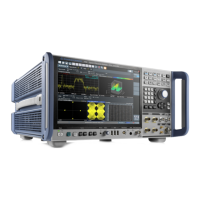Network and Remote Operation
R&S
®
FSW
798User Manual 1173.9411.02 ─ 43
Windows Firewall Settings
A firewall protects an instrument by preventing unauthorized users from gaining access
to it through a network. Rohde & Schwarz highly recommends the use of the firewall on
your instrument. R&S instruments are shipped with the Windows firewall enabled and
preconfigured in such a way that all ports and connections for remote control are
enabled. For more details on firewall configuration see the Windows 10 help system
and the R&S White Paper (available from the Rohde & Schwarz website):
1EF96: Malware Protection Windows 10
13.6.1.1 How to Connect the Instrument to the Network
There are two methods to establish a LAN connection to the instrument:
●
A non-dedicated network (Ethernet) connection from the instrument to an existing
network made with an ordinary RJ-45 network cable. The instrument is assigned
an IP address and can coexist with a computer and with other hosts on the same
network.
●
A dedicated network connection (Point-to-point connection) between the instru-
ment and a single computer made with a (crossover) RJ-45 network cable. The
computer must be equipped with a network adapter and is directly connected to the
instrument. The use of hubs, switches, or gateways is not required, however, data
transfer is still performed using the TCP/IP protocol. An IP address has to be
assigned to the instrument and the computer, see Chapter 13.6.1.2, "How to
Assign the IP Address", on page 798.
Note: As the R&S FSW uses a 1 GBit LAN, a crossover cable is not necessary
(due to Auto-MDI(X) functionality).
► To establish a non-dedicated network connection, connect a commercial RJ-45
cable to one of the LAN ports.
To establish a dedicated connection, connect a (crossover) RJ-45 cable between
the instrument and a single PC.
If the instrument is connected to the LAN, Windows automatically detects the network
connection and activates the required drivers.
The network card can be operated with a 1 GBit Ethernet IEEE 802.3u interface.
13.6.1.2 How to Assign the IP Address
Depending on the network capacities, the TCP/IP address information for the instru-
ment can be obtained in different ways.
●
If the network supports dynamic TCP/IP configuration using the Dynamic Host
Configuration Protocol (DHCP), all address information can be assigned automati-
cally.
●
If the network does not support DHCP, or if the instrument is set to use alternate
TCP/IP configuration, the addresses must be set manually.
How to Set Up a Network and Remote Control

